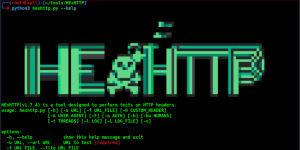OSINT Tool: NetScout

Reading Time: 2 Minutes
NetScout
NetScout by Caio Ishikawa is an OSINT tool that finds domains, subdomains, directories, endpoints and files for a given seed URL. It consists of the following components:
- BinaryEdge client: Gets subdomains
- DNS: Attempts to perform a DNS zone transfer to extract subdomains
- Crawler: Gets URLs and directories from the found subdomains + the seed url
- SERP client: Gets links for files. It uses Google dorking techniques to search for specific file types based on file extensions found by the crawler
- Shortened URL scan: This module leverages the URLTeam’s lists of shortened URLs. It downloads the list that was last uploaded, and checks every entry for a host that matches the seed URL’s host. These text files can be very large (>500mb), and this scan takes several minutes. This module was heavily inspired urlhunter.
See Also: A Practical Guide to Hacking Techniques for finding Top Bugs.
The Bug Bounty Hunting Course
Setup
How to install
- Go install: – Run
go install github.com/caio-ishikawa/netscout@latest - Build from source: – Clone repository – Run
make install
External APIs
NetScout uses two external APIs: BinaryEdge and SerpAPI. BinaryEdge is used to query for historical data of subdomains registered to the seed URL, and SERP API is used to collect Google Search results for speficic filetypes for the seed URL.
Setting API keys
NetScout expects the API keys to be set as environment variables:
export BINARYEDGE_API_KEY="<key>"export SERP_API_KEY="<key>"
See Also: Recon Tool: SauronEye
Examples
Usage:
=======================================================================
███▄ █ ▓█████▄▄▄█████▓ ██████ ▄████▄ ▒█████ █ ██ ▄▄▄█████▓
██ ▀█ █ ▓█ ▀▓ ██▒ ▓▒▒██ ▒ ▒██▀ ▀█ ▒██▒ ██▒ ██ ▓██▒▓ ██▒ ▓▒
▓██ ▀█ ██▒▒███ ▒ ▓██░ ▒░░ ▓██▄ ▒▓█ ▄ ▒██░ ██▒▓██ ▒██░▒ ▓██░ ▒░
▓██▒ ▐▌██▒▒▓█ ▄░ ▓██▓ ░ ▒ ██▒▒▓▓▄ ▄██▒▒██ ██░▓▓█ ░██░░ ▓██▓ ░
▒██░ ▓██░░▒████▒ ▒██▒ ░ ▒██████▒▒▒ ▓███▀ ░░ ████▓▒░▒▒█████▓ ▒██▒ ░
░ ▒░ ▒ ▒ ░░ ▒░ ░ ▒ ░░ ▒ ▒▓▒ ▒ ░░ ░▒ ▒ ░░ ▒░▒░▒░ ░▒▓▒ ▒ ▒ ▒ ░░
░ ░░ ░ ▒░ ░ ░ ░ ░ ░ ░▒ ░ ░ ░ ▒ ░ ▒ ▒░ ░░▒░ ░ ░ ░
░ ░ ░ ░ ░ ░ ░ ░ ░ ░ ░ ░ ▒ ░░░ ░ ░ ░
░ ░ ░ ░ ░ ░ ░ ░ ░
=======================================================================
Usage:
-u string
A string representing the URL
-d int
An integer representing the depth of the crawl
-t int
An integer representing the amount of threads to use for the scans (default 5)
-delay-ms int
An integer representing the delay between requests in miliseconds
-lock-host
A boolean - if set, it will only save URLs with the same host as the seed
-o string
A string representing the name of the output file
-v
A boolean - if set, it will display all found URLs
-skip-axfr
A bool - if set, it will skip the DNS zone transfer attempt
-skip-binaryedge
A bool - if set, it will skip BinaryEdge subdomain scan
-skip-google-dork
A bool - if set, it will skip the Google filetype scan
-headless
A bool - if set, all requests in the crawler will be made through a headless Chrome browser (requires Google Chrome)
-deep
A bool - if set, the shortened URL scan will be performed (can take several minutes)
Sets seed url, depth, and output file:
netscout -u https://crawler-test -d 2 -o netscout.txt
Skips BinaryEdge and Google dork:
netscout -u https://crawler-test.com -d 2 --skip-binaryedge --skip-google-dork -o netscout.txt
Sets thread count to 5, req delay to 1000ms, and forces requests to be made throught a headless Chrome browser.
netscout -u https://crawler-test.com -d 2 -t 5 --delay-ms 1000 --headless -o netscout.txt
Enables the shortened URL scan, sets crawler depth to 2, and threads to 5
netscout -u https://crawler-test.com --deep -d 2 -t 5
Testing
The tests are placed in the same directory as the tested file, and the crawler tests require the DVWA (Damn Vulnerable Web App) to be running locally with port 80 exposed. Before running the tests, the test files must be set up.
All the setup needed for the tests are handled in the Makefile:
- To pull the DVWA image, run
make test-container-pull - To setup the test files
make testfiles-setup - To run the container
make test-container-run - To run the tests
make test - To teardown the test files
make testfiles-teardown
Clone the repo from here: GitHub Link









